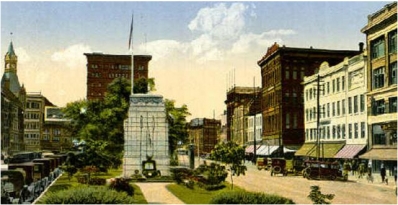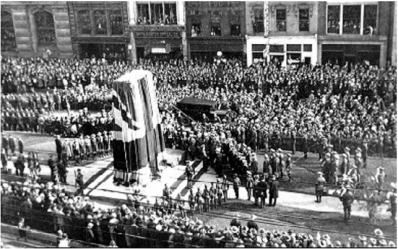The HPL App and catalogue are not showing materials borrowed through OverDrive. Please use the Libby app or hpl.overdrive.com to view these items. We aim to fix it quickly. Thank you for your patience.
The accessibility door at Waterdown Branch is not working. We aim to fix it quickly.
The Makerspace at Central Library is currently out of white vinyl for printing. Members needing white vinyl can visit the Dundas or Valley Park branch Makerspaces, which are the closest locations with white vinyl currently available.
Due to maintenance, the Barton Branch will be closed on Wednesday, January, 7. Please visit Central Library or Kenilworth Branch for your library needs. www.hpl.ca/hours
Daily print balances for black and white and colour printing change January 2, 2026. The new daily print balance is 40 cents. Members receive four free black and white copies or two free colour copies.
Large format and vinyl printing pricing also change on January 2. Visit https://www.hpl.ca/makerspaces for updates.
Bookmobile is off the road December 31, and January 1st. Visit www.hpl.ca/bookmobile for our Holiday Schedule.
Due to the setup for the Noon Hour Concert, the Fourth Floor at Central Library will be closed on Friday, January 2. Makerspace and Newcomer Learning Centre will remain open. Floors 1-3 have spaces to work and study.
All branches close on Thursday January 1 for New Years Day. This includes branches with Extended Access.
All HPL Branches close early on Wednesday, December 31 at 1pm. This includes branches with Extended Access.
Branch Study Halls are paused Friday, December 19, 2025 through Monday, January 5, 2026. Central Library Study Hall hours resume Spring 2026.
www.hpl.ca/study-halls
Bring back your borrowed library items (due Oct 1 or later) within 28 days to avoid a replacement or lost fee. We'll remove the fee when you bring back your overdue items.
Cenotaph

The Cenotaph was erected through the efforts of the Canadian Club of Hamilton to commemorate “Our Glorious Dead” who sacrificed their lives during the First World War. The plan to construct the Cenotaph was initially proposed by John Stephen, President of the Canadian Club of Hamilton on Thursday, June 23, 1921. It was to replace the Canadian Club flag pole. The architect who was chosen to design the Cenotaph was William Russell Souter (1894-1971). Souter was an up and coming architect who was a partner in the Hutton and Souter architectural firm. The monument was estimated to cost between five and six thousand dollars. President Stephen felt the funds required could be raised by all of the Canadian Clubs in Hamilton.
The process of constructing the monument encountered many obstacles. Much to the chagrin of Hamilton citizens, the Canadian Club of Hamilton decided to construct the memorial of Canadian Queenston limestone. The Queenston limestone had a shorter life span and was considered to be a poorer material to use for the construction of a memorial. Fortunately, the decision was overturned and the memorial was made of granite, since it was a harder stone and required less maintenance than limestone. The magnificent granite memorial was unveiled at 5:00 p.m. on May 22, 1923 by the Governor General, Viscount Byng of Vimy. Viscount Byng was recognized for leading the Canadians into France and Flanders. During the ceremony, two minutes of silence were respected. All motion and noise ceased as motorists on nearby streets stopped to join the spectators in paying their respects to the soldiers who had died aiding the Allies in the First World War.
The Cenotaph commemorated the 53,000 Canadian soldiers, 2,000 of them Hamiltonians, who were killed during the First World War. Our soldiers exhibited great courage and prowess and earned Canada recognition in the Imperial War Cabinet. Canadian soldiers stormed the well defended natural fortress, Vimy Ridge on the western front, even though the battleground had managed to withstand attacks from both the British and French forces for over two and a half years. Canada was also granted a seat at peace conferences held in Versailles.

The Cenotaph is located in Hamilton's Gore Park and is a replica of the British Cenotaph in Westminster, London. The landmark consists of a huge granite column with an apparent casket at its summit. Two smaller columns are at its side. Mounted on the two columns are carved replicas of the equipment used by Canadian troops in the First World War. Three powerful words are embedded in the Cenotaph commemorating our brave soldiers who fought for freedom, “Our Glorious Dead”. Overtime, several suggestions were brought forward to the United Council of Veterans regarding the improvement of the Cenotaph. On March 19, 1953, the council received a sketch of the memorial with improvements that included bronze posts linked together by a bronze plated steel chain. The bronze posts were intended to house the badges that were issued to veterans of both World Wars. Other improvements included the addition of shrubbery and flood lighting at night. The estimated cost for the alterations was two thousand dollars. A few months later, these proposed improvements were approved. The Cenotaph stands as a gesture from those citizens who give thanks to the Canadian soldiers who sacrificed their lives in War.
“Drink! to our fathers who begot us men,
To the dead voices that are never dumb;
Then to the land of all our loves, and then
To the long parting and the age to come.”
Sir Henry Newbolt
References
Clipping File. Hamilton - Memorials - Cenotaph. Local History & Archives, HPL.
Hamilton City Planning Scrapbook. Local History & Archives, HPL. (R711.409713 H18 vol.4 pg.7)
Herald Scrapbooks. Local History & Archives, HPL. (Microfilm Collection Vol. W3 pt.2 WWI, p.57, 61, 62-63)
McCullough: Essays on Canadian History. Local History & Archives, HPL. (R971.M39 vol.3 pg.22)
Our Heritage Scrapbooks. Local History & Archives, HPL. (R917.1352 OUR vol.2 pg.105-106)












